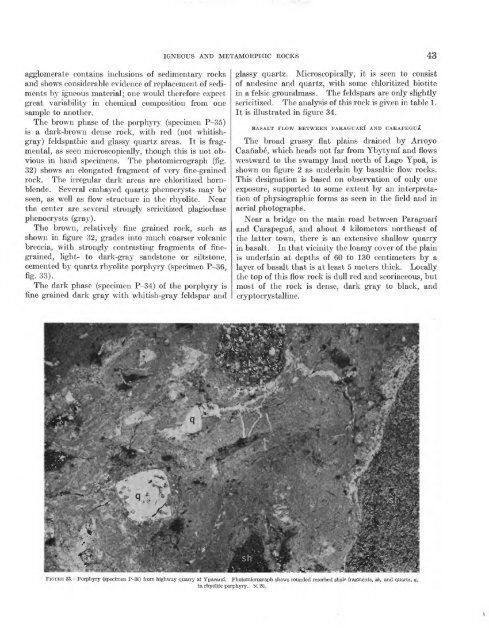Geology and Mineral Resources of Paraguay A Reconnaissance
Geology and Mineral Resources of Paraguay A Reconnaissance
Geology and Mineral Resources of Paraguay A Reconnaissance
- No tags were found...
Create successful ePaper yourself
Turn your PDF publications into a flip-book with our unique Google optimized e-Paper software.
IGNEOUS AND METAMORPHIC ROCKS 43agglomerate contains inclusions <strong>of</strong> sedimentary rocks<strong>and</strong> shows considerable evidence <strong>of</strong> replacement <strong>of</strong> sedimentsby igneous material; one would therefore expectgreat variability in chemical composition from onesample to another.The brown phase <strong>of</strong> the porphyry (specimen P-35)is a dark-brown dense rock, with red (not whitishgray)feldspathic <strong>and</strong> glassy quartz areas. It is fragmental,as seen microscopically, though this is not obviousin h<strong>and</strong> specimens. The photomicrograph (fig.32) shows an elongated fragment <strong>of</strong> very fine-grainedrock. The irregular dark areas are chloritized hornblende.Several embayed quartz phenocrysts may beseen, as well as flow structure in the rhyolite. Nearthe center are several strongly sericitized plagioclasephenocrysts (gray).The brown, relatively fine grained rock, such asshown in figure 32, grades into much coarser volcanicbreccia, with strongly contrasting fragments <strong>of</strong> finegrained,light- to dark-gray s<strong>and</strong>stone or siltstone,cemented by quartz rhyolite porphyry (specimen P-36,fig. 33).The dark phase (specimen P-34) <strong>of</strong> the porphyry isfine grained dark gray with whitish-gray feldspar <strong>and</strong>glassy quartz. Microscopically, it is seen to consist<strong>of</strong> <strong>and</strong>esine <strong>and</strong> quartz, with some chloritized biotitein a felsic groundmass. The feldspars are only slightlysericitized. The analysis <strong>of</strong> this rock is given in table 1.It is illustrated in figure 34.BASALT FLOW BETWEEN PARAGTJARI AND CAEAPEGuAThe broad grassy flat plains drained by ArroyoCaanabe, which heads not far from Ybytymi <strong>and</strong> flowswestward to the swampy l<strong>and</strong> north <strong>of</strong> Lago Ypoa, isshown on figure 2 as underlain by basaltic flow rocks.This designation is based on observation <strong>of</strong> only oneexposure, supported to some extent by an interpretation<strong>of</strong> physiographic forms as seen in the field <strong>and</strong> inaerial photographs.Near a bridge on the main road between Paraguari<strong>and</strong> Carapegua, <strong>and</strong> about 4 kilometers northeast <strong>of</strong>the latter town, there is an extensive shallow quarryin basalt. In that vicinity the loamy cover <strong>of</strong> the plainis underlain at depths <strong>of</strong> 60 to 130 centimeters by alayer <strong>of</strong> basalt that is at least 5 meters thick. Locallythe top <strong>of</strong> this flow rock is dull red <strong>and</strong> scoriaceous, butmost <strong>of</strong> the rock is dense, dark gray to black, <strong>and</strong>cryptocrystalline.FIGUEE 33. Porphyry (specimen P-36) from highway quarry at Ypacaral. Photomicrograph shows rounded resorbed shate fragments, sh, <strong>and</strong> quartz, q,in rhyolite porphyry. X 20.
















